Riding Rock Resort, San Salvador, BahamasContents of this Issue: Riding Rock Resort, San Salvador, Bahamas Indonesia Begins to Reopen for Diving Trips – Maybe Not! The Pacific Quartet, the Caribbean, and Great Whites The Boy in October Sky Became a Man Who Taught Astronauts to Dive Car Tires Discarded in the Ocean Trap Hermit Crabs Forever U.S. Dive Boat Owner’s Liability Might Increase Dive Travel in the Time of Coronavirus The GoPro Selfie-Stick as Unwanted Shark Bait Anything It Takes to Get My Shot PFO – That Perfectly Formed Hole It’s Not OK to Sell Dive Gear to Libya American Gold Salvors Spared Criminal Action Editorial Office: Ben Davison Publisher and Editor Undercurrent 3020 Bridgeway, Suite 102 Sausalito, CA 94965 a dive resort awakens, post-pandemic… from the November, 2021 issue of Undercurrent
Dear Fellow Diver, If it weren't for my Jonesing for the reefs after an 18-month pandemic hiatus, I wouldn't book an August trip to the Bahamas, where it's hot, humid, and the threat of a hurricane lingers. But I just had to get back in the water, away from crowds. So I got a good price for my four friends and me at Riding Rock Resort, San Salvador Island, population 1200, where COVID has been almost nonexistent, and headed off for the excellent wall diving.
At 5:30 p.m., I checked in to the same room I had 12 years ago, then, with the usual rum punch in hand, I was ready to pepper Michelle, the long-time manager, and dive leader Bruce with questions about the diving operation and schedule. But my more significant questions were, would the diving measure up to what it was 12 years ago when I reviewed it for Undercurrent https://tinyurl.com/fwkmdjcy and would being the first group at a reopening resort work out smoothly? Well, diving with Guanahani Divers pretty much did measure up, with some exceptions. Sand Castle was a typical second or third dive. I kicked past sea fans and then dropped over the lip of the wall to 75 feet and eased along -- Bruce was fine with the slow, exploratory dive style of our group -- finding squirrelfish and a tiny arrow blenny in holes. As on other dives, 6- to 7-foot Caribbean reef sharks patrolled the waters. They seem acclimated to divers, and I quickly acclimated to them. Like on most of the dives, my computer logged a max depth of about 80 feet. I saw nice live boulder (elephant ear) coral and a few wire corals, and up top, along the sand bottom, small patches of live coral, where I was greeted by an ever-intriguing mixed school of streaming blue chromis, bluehead wrasse, and other small wrasses. A variety of parrotfish was on hand, including stoplight, red band, princess, and striped. I watched a Spanish hogfish clean the gunk off a barracuda as a mutton snapper waited its turn. I was stunned when a reef shark passed by with a huge rusted hook poking through its mouth. For a moment, I wondered if I could remove it, then thought better. The sand bottom was a lively home for fish, with a half-buried yellow stingray, rosy razorfish, a striped moray under a little coral head, and a meadow of garden eels. One of my fellow divers went wild at the sight of a tiger tail sea cucumber poking out -- his first-ever sighting. At the safety stop, I watched bar jacks and horse-eyed jacks make downward dives at the garden eels, with no better luck than I would have. But, I saw no hammerheads, which in the past were quite common. I worried about their survival, but Bruce explained that he rarely sees them in the summer (where do they go?). Once, a seven-foot hammer made a close pass by my friends, but I was off doing my own thing and missed it. The dive schedule is typical for a little resort. Start with an early breakfast, then walk about five minutes to the marina a get ready for an 8:30 a.m. boat departure. Most sites are close-by, so we returned to the marina for the morning interval, then headed back out to dive again, returning well before noon. Afternoon dives were usually at 2:30, and by 4 p.m., I was back in my room for a shower, with time to relax before joining happy hour at the bar, then on to dinner.
After dinner, we had a nightcap at the bar, often joined by a staffer or two. One night we broke out the karaoke machine and talked Michelle into joining us briefly. She put the gringos to shame, belting out "I Will Survive." The wi-fi worked well in the restaurant and bar, so if we got tired of talking about diving and politics, we could check our email or catch up on news.
For each dive, Bruce and captain Tony were always ready on time, the steel tanks were filled to 3000-3200 psi, towels and cold water were on the boat, and our equipment was set up. They handled well the few needs we had, like when my 34-year old pressure gauge died. Bruce swapped out the dead gauge with a loaner. Their dive boat, which supposedly handles 18 divers -- that would be tight -- had plenty of shade to sit out of the sun. One morning, five divers off a small cruise boat joined us five, and we had plenty of room. The crew helped us senior divers with gear handling to get us to the stern for a giant stride, and on the return, gave a hand up the ladder. They hung a weighted 25-foot line off the stern if someone wanted to use it for a safety stop and had a regulator hanging at 20 feet. Each afternoon, they rinsed the gear on the boat; I didn't lug or wash my gear until departure day. Bruce, who has been with the resort for many years, knows the reefs well, but you are on your own as far as finding interesting creatures; at one point, I asked if he could help find small stuff, and he said, "your wife is better at that than I am." (And, I don't have to tip her.) He led the group loosely, with no babysitting, getting us back near the mooring at 45 minutes, where we could explore for another 10-15 minutes. I was a bit annoyed that he sometimes handled animals, such as picking a brittle star out of a sponge, but he was careful.
The most interesting first dives are about 20-25 minutes of boat travel south, near the island's tip, where cracks in the wall allow for big swim-thrus, crevices, and tunnels. At 'North Pole', I entered an opening at 50 feet and made like Santa going down the chimney. It flattened out, and I entered the blue at 133 feet, in time to see a cero mackerel jet by. Like most walls here, there are giant barrel sponges that may actually be bigger than a barrel. I found a couple of bright orange crinoids, then followed Bruce into a crevice and up to the top of the wall at 40 feet, where white and blue striped grunts, chubs, schoolmasters, and black durgons milled around. Back at the boat, horse-eye jacks were circling. Being part of the first group at the post-COVID reopening made me dive more conservatively, especially since there was no operational chamber on San Sal. Club Med Columbus Isle had one until Hurricane Joaquin destroyed the resort, and it won't open until late next near. Riding Rock didn't have Nitrox -- maybe early next year -- so I was extra careful.
I made the obligatory visit to the Columbus landing site, where there is a small monument. Columbus landed on this island on October 12, 1492. He thus "discovered America" right here and named it San Salvador (Holy Savior). He encountered the Guanahani people, and you know that this story ended very badly for them. Is this a dive destination for you? The reefs are algae-heavy but still fishy and loaded with sharks. The cave and crack dives leading into the blue on the deep wall are the prime attraction. So, if you like getting away from crowds, enjoy an island -- and hotel -- that seems locked in the 20th century, and having the reefs to yourself, you may want to put it on your wish list. But, I must end on a sorry note. Anyone who's been diving for very long has seen first-hand what is happening to our planet, with coral reefs being a leading edge of climate change. In the 12 years since I previously dived San Salvador, there has been a noticeable deterioration of live coral. Sure, there are live patches and a little fresh elkhorn and staghorn growth, but most of the reef is dead, algae-covered, worse than many other Atlantic/Caribbean reefs. And mind you, this is an island with no industry, insignificant agricultural and sewage runoff, and little fishing or diving pressure. What will the next generation see? - M.A. Our undercover author has been diving with his naturalist partner, mainly in the Caribbean, for 35 years, often at off-the-tourist-trail locations. He says, "if you care about the future of coral reefs and the planet, get active politically." He has written several articles for Undercurrent.
|

I want to get all the stories! Tell me how I can become an Undercurrent Online Member and get online access to all the articles of Undercurrent as well as thousands of first hand reports on dive operations world-wide
| Home | Online Members Area | My Account |
Login
|
Join
|
| Travel Index |
Dive Resort & Liveaboard Reviews
|
Featured Reports
|
Recent
Issues
|
Back Issues
|
|
Dive Gear
Index
|
Health/Safety Index
|
Environment & Misc.
Index
|
Seasonal Planner
|
Blogs
|
Free Articles
|
Book Picks
|
News
|
|
Special Offers
|
RSS
|
FAQ
|
About Us
|
Contact Us
|
Links
|
3020 Bridgeway, Ste 102, Sausalito, Ca 94965
All rights reserved.

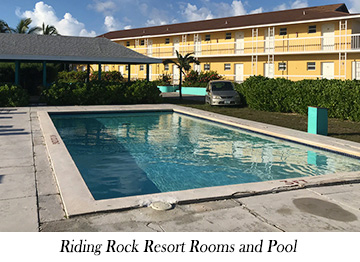 It's a joy to arrive at a small airport, where everyone is friendly, the luggage comes to you on a four-wheeled cart, and the only stuff to buy is Bahamian beer or rum. I did have to show my CDC vaccination card to multiple people, and that's good. Bahamians take COVID precautions seriously, and everyone always wore a mask indoors. Aside from COVID, the island is not much different than it was several decades ago, a real treat in today's world.
It's a joy to arrive at a small airport, where everyone is friendly, the luggage comes to you on a four-wheeled cart, and the only stuff to buy is Bahamian beer or rum. I did have to show my CDC vaccination card to multiple people, and that's good. Bahamians take COVID precautions seriously, and everyone always wore a mask indoors. Aside from COVID, the island is not much different than it was several decades ago, a real treat in today's world.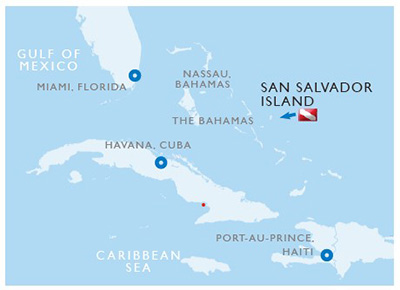 The food was good, and there was plenty of it. For breakfast, I usually
ordered an omelet, bacon, and toast, but one could go lighter with fresh fruit
and yogurt and fruit. Lunch and dinner always started with a salad and an offer
of soup (often excellent conch chowder), and usually a choice of entrees. It was
often familiar fare, such as fried chicken, but sometimes it featured conch or grilled grouper. The fresh-made desserts were great: carrot cake, coconut pie, key lime pie with whipped cream, and bread pudding. But aside from the delicious happy-hour conch fritters served on the first day, there were no more bar snacks. Oh well. The restaurant and bar are spacious, having been rebuilt after the 2015 hurricane. While we could eat or drink outside on the terrace overlooking the ocean, during my August trip, it was too hot while the sun was up and often too buggy.
The food was good, and there was plenty of it. For breakfast, I usually
ordered an omelet, bacon, and toast, but one could go lighter with fresh fruit
and yogurt and fruit. Lunch and dinner always started with a salad and an offer
of soup (often excellent conch chowder), and usually a choice of entrees. It was
often familiar fare, such as fried chicken, but sometimes it featured conch or grilled grouper. The fresh-made desserts were great: carrot cake, coconut pie, key lime pie with whipped cream, and bread pudding. But aside from the delicious happy-hour conch fritters served on the first day, there were no more bar snacks. Oh well. The restaurant and bar are spacious, having been rebuilt after the 2015 hurricane. While we could eat or drink outside on the terrace overlooking the ocean, during my August trip, it was too hot while the sun was up and often too buggy.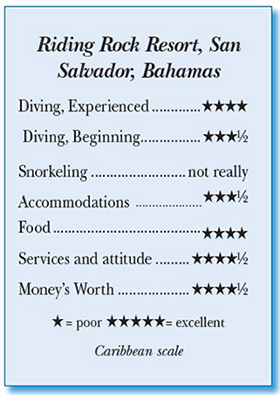 The hotel and its rooms, generically furnished, look like an old Holiday Inn but well-fortified to stand up to hurricanes. A good thing because Hurricane Joaquin devastated the island in 2015. The bar and lodge had to be rebuilt, but the hotel stood firm. My second-story room showed a little wear, but nothing serious, and had a balcony overlooking the tropical Atlantic. The TV didn't work -- the cable company's fault -- and the A/C took hours to get the hot room cool the first day. After that, it worked fine. Good thing, because it was mostly too hot to sit outside on the terrace. The summer heat had one advantage: I stashed my three-mil wetsuit to go bare in the 82-degree water. In the winter, land temperatures are pleasant, but the water can drop to the mid-70s, chilly to me.
The hotel and its rooms, generically furnished, look like an old Holiday Inn but well-fortified to stand up to hurricanes. A good thing because Hurricane Joaquin devastated the island in 2015. The bar and lodge had to be rebuilt, but the hotel stood firm. My second-story room showed a little wear, but nothing serious, and had a balcony overlooking the tropical Atlantic. The TV didn't work -- the cable company's fault -- and the A/C took hours to get the hot room cool the first day. After that, it worked fine. Good thing, because it was mostly too hot to sit outside on the terrace. The summer heat had one advantage: I stashed my three-mil wetsuit to go bare in the 82-degree water. In the winter, land temperatures are pleasant, but the water can drop to the mid-70s, chilly to me.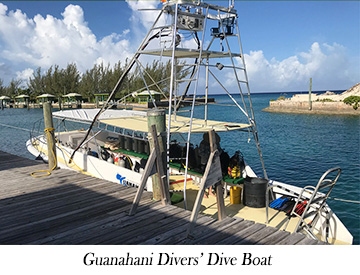 "Twin Peaks" was a nice dive, where I kicked out over the sand to get to coral peak #1. I spotted a green turtle in a break in the wall munching on a sponge as two gray angels, goatfish, and black 'durgons eagerly cleaned up the scraps. That upped my mood, and I loved the rest of the dive. A Nassau grouper and a schoolmaster lined up to be cleaned. Up top, past the sea fans, I found a corkscrew anemone housing eight Peterson shrimp. As I swam over sand tilefish and jawfish, I saw the other divers were fascinated by an outsized reef shark, which looked almost inflated, clearly pregnant.I saw the other divers were fascinated by an outsized reef shark, which looked almost inflated, clearly pregnant. Oddly, I saw few lionfish on my dives, very different from my last visit here. Visibility, by the way, was usually 70-80 feet.
"Twin Peaks" was a nice dive, where I kicked out over the sand to get to coral peak #1. I spotted a green turtle in a break in the wall munching on a sponge as two gray angels, goatfish, and black 'durgons eagerly cleaned up the scraps. That upped my mood, and I loved the rest of the dive. A Nassau grouper and a schoolmaster lined up to be cleaned. Up top, past the sea fans, I found a corkscrew anemone housing eight Peterson shrimp. As I swam over sand tilefish and jawfish, I saw the other divers were fascinated by an outsized reef shark, which looked almost inflated, clearly pregnant.I saw the other divers were fascinated by an outsized reef shark, which looked almost inflated, clearly pregnant. Oddly, I saw few lionfish on my dives, very different from my last visit here. Visibility, by the way, was usually 70-80 feet.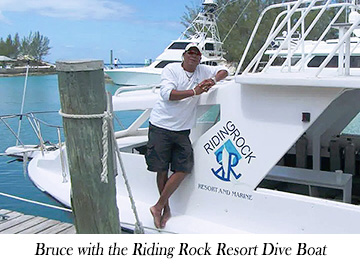 The genial Williams family has owned Riding Rock Resort for more than 30 years. Michelle, the personable operations manager, remembered my partner and me from years back. They run an informal car rental, so on our last day, with no afternoon dive, we rented a car for $60 and toured the island ("keep to the left"), walked a deserted beach, looked for birds, climbed a lighthouse, had dinner at a small restaurant on the island, and ended up with a bunch of local folks at Wendy's outdoor bar, across the street from the airport. That was fun, till the sand flies suggested that I return to Riding Rock.
The genial Williams family has owned Riding Rock Resort for more than 30 years. Michelle, the personable operations manager, remembered my partner and me from years back. They run an informal car rental, so on our last day, with no afternoon dive, we rented a car for $60 and toured the island ("keep to the left"), walked a deserted beach, looked for birds, climbed a lighthouse, had dinner at a small restaurant on the island, and ended up with a bunch of local folks at Wendy's outdoor bar, across the street from the airport. That was fun, till the sand flies suggested that I return to Riding Rock. Divers Compass: I got a discount for our group and paid $1506 directly to RR for an all-inclusive, double occupancy package, with 16 dives, for a Saturday to Saturday trip . . . tips to the resort and boat crew and bar bill were extra ... no night dives were offered and there is no shore diving . . . Bahamasair connector between Nassau and San Sal was $267rt; you don't want to miss your Saturday connection because the next flight will be Wednesday . . . On return, I had to stay over Saturday night in Nassau; booked a cheap room at a downtown Holiday Inn and walked to the "fish fry" area for a nice evening before flying home Sunday morning . . . U.S. dollars and plastic are accepted widely . . . COVID: I had to get a Bahamas "health passport" online to enter the country, which was easily done by scanning my vaccination card, and cost $30 as health insurance . . . to re-enter the USA, I needed a negative test within three days of return flight, which Riding Rock arranged on site. Web site
Divers Compass: I got a discount for our group and paid $1506 directly to RR for an all-inclusive, double occupancy package, with 16 dives, for a Saturday to Saturday trip . . . tips to the resort and boat crew and bar bill were extra ... no night dives were offered and there is no shore diving . . . Bahamasair connector between Nassau and San Sal was $267rt; you don't want to miss your Saturday connection because the next flight will be Wednesday . . . On return, I had to stay over Saturday night in Nassau; booked a cheap room at a downtown Holiday Inn and walked to the "fish fry" area for a nice evening before flying home Sunday morning . . . U.S. dollars and plastic are accepted widely . . . COVID: I had to get a Bahamas "health passport" online to enter the country, which was easily done by scanning my vaccination card, and cost $30 as health insurance . . . to re-enter the USA, I needed a negative test within three days of return flight, which Riding Rock arranged on site. Web site 